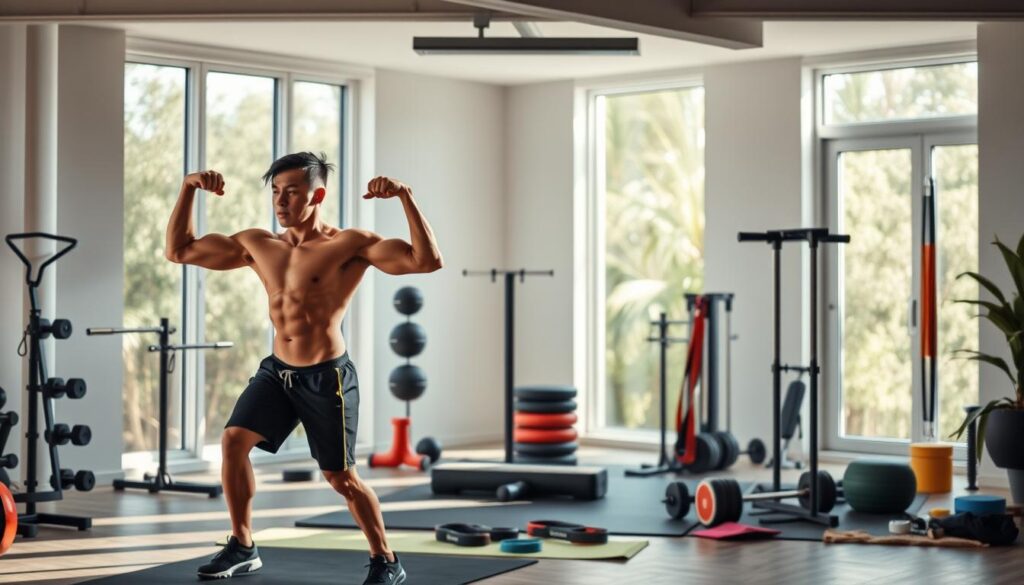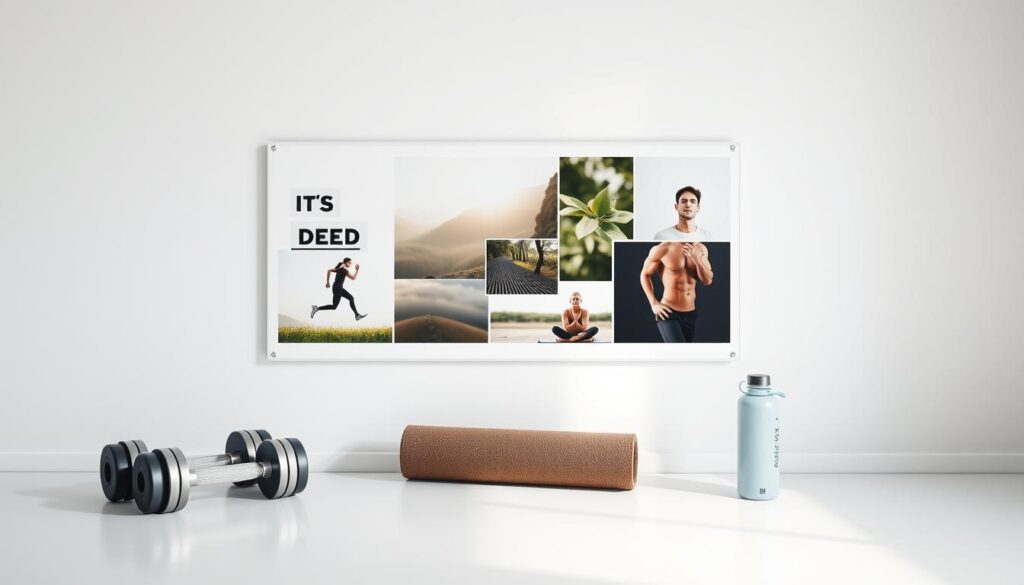Starting a fitness transformation journey is more than just working out and eating right. It needs a detailed plan that fits your personal goals and aspirations.

A customized fitness plan is key to success in fitness. By taking a holistic approach to fitness lifestyle design, you’ll see big improvements in your health.
Key Takeaways
- Understand the importance of a well-designed fitness plan.
- Learn how to create a customized fitness plan.
- Discover the benefits of a holistic approach to fitness.
- Achieve your fitness goals with a structured plan.
- Improve your overall well-being through fitness.
Understanding the Fitness Lifestyle Mindset
A fitness lifestyle is more than just getting fit. It’s about having a wellness mindset that affects every part of your life. This mindset is key to reaching and keeping your fitness goals.
Shifting from Diet Culture to Sustainable Habits
The old diet culture focuses on quick fixes and short-term solutions. These can harm your long-term health and fitness goals. To really adopt a fitness lifestyle, you need to focus on sustainable habits.
The Problem with Quick Fixes
Quick fixes, like fad diets and extreme workouts, might give you fast results. But they’re hard to keep up with. They can lead to yo-yo dieting and burnout, hurting your mental and physical health.
Building a Positive Relationship with Exercise
Having a good relationship with exercise is essential for a successful fitness lifestyle. It means finding activities you like and seeing exercise as self-care, not punishment.
The Connection Between Physical Fitness and Overall Wellness
Physical fitness is closely tied to overall wellness. Regular exercise not only boosts your physical health but also your mental well-being.
Mental Health Benefits of Regular Exercise
Regular exercise can help with anxiety and depression, improve your mood, and sharpen your mind. It’s a great way to keep your mental health strong.
How Fitness Improves Daily Life Quality
Regular physical activity can make your daily life better. It increases your energy, improves sleep, and boosts your physical abilities.
| Aspect of Wellness | Benefits of Fitness Lifestyle |
|---|---|
| Mental Health | Reduces symptoms of anxiety and depression, improves mood |
| Physical Health | Improves cardiovascular health, increases strength and flexibility |
| Daily Life Quality | Boosts energy levels, enhances sleep quality |
Defining Your Personal Fitness Goals
Setting personal fitness goals is key to a healthier life. 1st Fitness Lifestyle Design: Achieve Your Goals You must have clear and reachable objectives for success.
Setting SMART Fitness Objectives
Use the SMART criteria for effective goals: Specific, Measurable, Achievable, Relevant, and Time-bound. This makes your goals clear and doable.
Creating Measurable Milestones
Break down big goals into smaller, measurable steps. For example, if you want to run a marathon, start by running a certain distance each week. Then, increase your running time gradually.
Realistic Timeframes for Progress
Choose realistic timeframes to stay motivated and track your progress. Give yourself enough time to reach your goals without feeling rushed or discouraged.
| Goal Type | Example | Timeframe |
|---|---|---|
| Aesthetic | Losing 10 pounds | 3 months |
| Performance | Running a marathon | 6 months |
| Health | Lowering blood pressure | 2 months |
Balancing Aesthetic, Performance, and Health Goals
It’s important to balance aesthetic, performance, and health goals. Focusing too much on one can neglect others, leading to fitness imbalances.
Creating Your Fitness Vision Board
A fitness vision board is a visual of your goals. It’s a motivational tool to keep you focused. Include images, quotes, and other inspiring elements.

The Essentials of Fitness Lifestyle Design
To make a fitness lifestyle that fits you, know where you start and pick activities you like. This way, your fitness journey will be both good and lasting.
Assessing Your Current Fitness Level
Before you start your fitness plan, find out where you are now. This helps you see what you’re good at and what you need to work on.
Self-Assessment Tools and Techniques
Use tools like fitness trackers or online quizzes to get a feel for your fitness. Keeping a journal of your daily activities and feelings can also help. These tools give you important info about your fitness level.
When to Seek Professional Evaluation
If you’re not sure about your fitness or have health worries, get a pro’s opinion. A certified trainer or doctor can give you advice and help you set goals that are just right for you.
Choosing Activities You Actually Enjoy
Picking activities you love is key to keeping up with your fitness routine. Whether it’s running, swimming, or dancing, enjoying your workout makes it easier to keep going.
Designing a Balanced Weekly Schedule
A good fitness plan mixes strength training, cardio, and flexibility exercises. Plan your week to include all these, for a balanced fitness approach.
Incorporating Strength, Cardio, and Flexibility
Make sure your week includes a variety of exercises. For example, some days for strength training, others for cardio activities like jogging or cycling. Don’t forget flexibility exercises like yoga or stretching.
Planning Rest and Recovery Days
Rest and recovery are as important as workout days. Include rest days in your plan to let your body recover and get stronger. This makes your fitness routine more effective over time.
By following these tips, you can make a fitness lifestyle that’s right for you, fun, and lasting.
Nutrition Strategies for Your Fitness Journey
To reach your fitness goals, focus on nutrition as much as exercise. A balanced diet gives your body the fuel it needs. It helps you perform well, recover fast, and adapt to challenges.
Fueling Your Workouts Effectively
Good nutrition before and after workouts is key. Pre-workout nutrition should include carbs and protein 1-3 hours before. This gives you energy and supports muscles.
Pre-Workout Nutrition
Choose a meal or snack with complex carbs and lean protein. Try oatmeal with banana and almond butter or Greek yogurt with berries and granola.
Post-Workout Recovery Meals
After working out, eat carbs and protein within 30-60 minutes. A smoothie with protein powder, fruit, and spinach or chicken with quinoa and veggies are great choices.
Meal Planning for Fitness Success
Good meal planning means a diet that supports your fitness goals. Include lean proteins, whole grains, and colorful veggies.
| Meal | Foods | Benefits |
|---|---|---|
| Breakfast | Oatmeal with fruits | Complex carbs, fiber |
| Lunch | Grilled chicken with quinoa | Lean protein, complex carbs |
| Dinner | Salmon with sweet potatoes | Protein, complex carbs, omega-3 |
Hydration and Supplementation Basics
Drinking enough water is crucial for performance. Daily water requirements depend on activity, climate, and individual needs.
Daily Water Requirements for Active Individuals
Drink at least 8-10 glasses of water daily. Adjust based on your activity and climate.
Supplements Worth Considering
While whole foods are best, some supplements can help. Protein powder, creatine, and BCAAs are good options. Always talk to a healthcare professional before starting new supplements
Building Consistency and Overcoming Obstacles
Keeping up with a fitness routine can be tough. But, with the right strategies, you can beat obstacles and reach your goals. Being consistent is key to making progress and seeing results 1st Fitness Lifestyle Design: Achieve Your Goals.
Creating Habits That Stick
To make lasting habits, start small and be steady. Habit stacking helps by adding new habits to ones you already do. This makes it easier to start new routines.
Habit Stacking Techniques
- Find a daily habit, like brushing your teeth.
- Add a new habit, like doing 10 push-ups after brushing.
- Slowly make the new habit more challenging.
Environmental Design for Success
Your surroundings greatly affect your fitness habits. Designing your space to support your goals can be a game-changer.
| Environmental Change | Benefit |
|---|---|
| Placing your workout clothes in a visible spot | Reminds you to work out |
| Removing junk food from your kitchen | Reduces temptation to eat unhealthy |
| Setting up a home workout area | Makes working out more convenient |
Navigating Fitness Plateaus
Plateaus are common in fitness. To get past them, try changing your routine or adding more intensity.
Adapting Your Plan During Life Changes
Life changes, like travel or stress, can affect your fitness. Travel strategies and adjusting during high-stress periods are key to staying consistent.
Travel Strategies for Maintaining Fitness
- Pack light workout gear.
- Research hotel fitness facilities or local workout options.
- Schedule workouts into your travel itinerary.
Adjusting During High-Stress Periods
When stressed, focus on self-care and keep some physical activity. This helps manage stress.

How to Start Your Fitness Lifestyle Journey
Starting your fitness journey is exciting but needs a solid plan. You should set realistic goals and find support. A clear plan helps you feel confident as you begin.
First Steps for Complete Beginners
First, know your current fitness level. Understand your strengths, weaknesses, and health concerns. It’s wise to talk to a healthcare professional if you have health issues.
Essential Equipment for Home Workouts
You don’t need much to start working out at home. Start with:
- A good pair of running shoes
- Resistance bands
- A yoga mat
- Dumbbells
As you get better, you can add more gear. Getting a few key items can make your workouts better and more varied.
Finding Supportive Communities
Being part of a fitness community helps a lot. Look for local gyms, online forums, or social media groups. Having people to support you makes a big difference.
Working with Fitness Professionals
Working with a personal trainer or coach is a good idea. They can give you a fitness plan made just for you. They also keep you on track.
Creating Accountability Systems
Having systems to keep you accountable is key. This includes:
- Fitness tracking apps
- Regular check-ins with a workout buddy
- Progress journals
Fitness Tracking Apps and Tools
Use apps like MyFitnessPal or Strava to track your progress. These tools help you stay motivated and adjust your plan.
Finding Workout Partners
Working out with a partner is motivating. Find someone with similar goals and likes. Having a workout buddy makes it more fun and helps you stay on track.
Conclusion: Embracing Your Fitness Lifestyle for Long-Term Success
Starting your fitness journey is exciting. Remember, fitness lifestyle design is about making a lasting change. By understanding the mindset, setting your goals, and focusing on nutrition, you’re on the path to long-term success.
Embracing fitness means more than just working out. It’s about living a healthy lifestyle. It’s about making choices that keep you well and balanced.
By following the advice in this article, you’re on your way to a healthier life. Stay dedicated to your goals, and soon you’ll be celebrating your achievements. Your journey to a better you begins today.
FAQ
What is fitness lifestyle design, and how can it help me achieve my fitness goals?
Fitness lifestyle design is a way to make a plan that fits you. It includes exercise, healthy eating, and wellness. This approach helps you reach your fitness goals and feel better overall.
How do I start a fitness lifestyle, and what are the first steps I should take?
Start by knowing your current fitness level and setting clear goals. Choose activities you like. Working with fitness experts can also help you make a plan that’s just right for you.
What role does nutrition play in a fitness lifestyle, and how can I fuel my workouts effectively?
Good nutrition is key for a fitness lifestyle. It gives you the energy and nutrients you need for exercise and recovery. Eat a balanced diet with protein, carbs, and healthy fats. Planning your meals and staying hydrated is also important.
How can I maintain consistency and overcome obstacles in my fitness journey?
To stay on track, make habits that last. Use techniques like habit stacking and design your environment. If you hit a plateau, change your plan. Life changes? Use travel tips and stress management to keep going.
What are some effective ways to track my progress and stay motivated in my fitness lifestyle?
Use apps and tools to track your progress. Having workout buddies and accountability systems helps too. A fitness vision board can also keep you inspired and focused on your goals.
How can I balance different types of fitness goals, such as aesthetic, performance, and health goals?
Prioritize your goals and plan accordingly. For example, strength training can improve health while working on looks or performance. This way, you can tackle multiple goals at once.
What are some common mistakes to avoid when starting a fitness lifestyle?
Don’t set unrealistic goals or rely on quick fixes. Remember to rest and recover too. Avoid comparing yourself to others. Focus on your own journey and progress.



